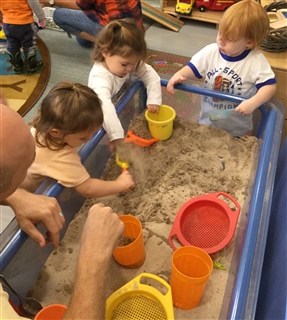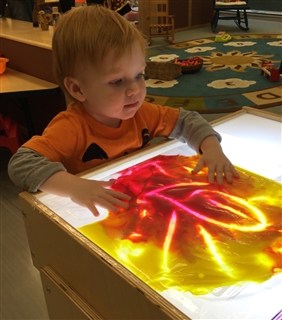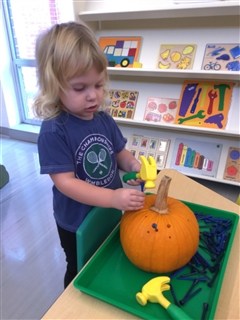Sensory activities provide children with a meaningful avenue for learning by facilitating exploration and naturally encouraging children to use scientific processes while they play, create, investigate, and explore. From infancy, children have learned about the world around them by touching, tasting, smelling, seeing, and hearing. Because children learn best by having “hands on” experiences with materials, sensory experiences are vital to young children’s learning.
Learning and retention improve when our senses are engaged. As children experiment with different sized containers in cornmeal or sand, they develop math skills such as size, conservation, counting, timing (how long it takes the sand to sift verses dirt), matching (finding the objects that match the chart or matching buttons, etc.), and classifying and sorting. As children manipulate the materials, they learn to understand concepts such as more/less, full/empty, and sink/float. Science concepts such as cause and effect, gravity, and solid to liquid can also explored.
Even before children can speak, they are developing an understanding of things in their environment by actively exploring them with all their senses. As they become more verbal, children can describe similarities and differences in what they see, hear, taste, touch, and smell. Children develop pre-writing skills as they pour, spoon, grasp, and work on eye-hand coordination tasks as they use the materials.
Self-discovery occurs as children become eager scientists. They practice making predictions, observations, and respond to their findings. In addition, children learn to cooperate and work together around a sensory table. As the children work together or side-by-side, they learn to understand someone else’s viewpoint. The children also have the opportunity to express themselves and become confident in sharing their ideas with others.
Children reinforce and practice their small motor skills while pouring, measuring, stirring, whisking, and manipulating the materials. They learn to control their movements and give their bodies directions to accomplish tasks as they explore. Gross motor skills are refined as children run through the sprinkler, paint with large paint brushes on the side of the building, and explore various mediums with their feet.
Sensory experiences provide open-ended opportunities where the process is more important than the product. Howchildren use the materials is much more important than what they make with them. Using creative thinking skills and expressing one’s creativity are important skills to nurture. Providing sensory experiences in a comfortable, accommodating environment can offer infants, toddlers, and preschool-age children lots of new, exciting, and beneficial opportunities. Taking into consideration children’s individual needs can really make them feel at ease and allow children to follow their interests!
Suggested Sensory Materials and Supplies
Mediums
Water
Sand
Dirt
Cornmeal
Rice
Macaroni
Soybeans
Sawdust
Dried Beans
Fingerpaint with additives (sand, glycerin, sawdust)
Fingerpaint in sealed plastic bags
Shaving Cream
Playdough
Confetti
Putty
Whipped Cream
Foam Pieces
Materials
Basters
Whisks
Waterwheels
Ice cubes (add food coloring)
Tongs
Sponges
Seashells
Soap Flakes
Cooking Utensils (measuring cups, funnels, spoons, etc.)
Combs
Vehicles
Funnels and sifters
Different kinds of bowls and containers
Cardboard tubes
Buttons
Dishwashing detergent
Rocks
Squeeze bottles
Buckets and pails










